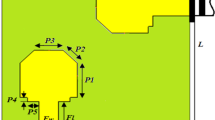Abstract
We analyze the bit error rate (BER) performance of a multiple-input multiple-output (MIMO) radio-frequency-identification (RFID) system employing orthogonal space-time block codes when the forward and backward channels exhibit independent but not necessarily identically distributed Nakagami-m fading. A closed-form upper bound on the BER performance is derived, and the corresponding diversity order is quantified. Numerical results provide some insight into the impact of several different parameters on the system performance.


Similar content being viewed by others
References
Tedjini S, Karmakar NC (2013) Chipless RFID, an emerging technology. Ann Telecommun 68:359
Mi M, Mickle MH, Capelli C, Swift H (2005) RF energy harvesting with multiple antennas in the same space. IEEE Antennas Propag Mag 47(5):100–106
Griffin JD, Durgin GD (2008) Gains for RF tags using multiple antennas. IEEE Trans Antennas Propag 56(2):563–570
Takahashi R, Terasaki K, Honma N, Tsunekawa Y (2014) Evaluating impact of tag element spacing on bit-error-rate performance using passive MIMO testbed. In: Proc ISAP. Kaohsiung, Taiwan, pp 285–286
Kim DY, Jo HS, Yoon H, Mun C, Jang B-J, Yook J-G (2010) Reverse-link interrogation range of a UHF MIMO-RFID system in Nakagami-m fading channels. IEEE Trans Ind Electron 57(4):1468–1477
Karmakar NC (2010) Handbook of smart antennas for RFID systems. Wiley, New Jersey
Zheng F, Kaiser T (2012) A space-time coding scheme for RFID MIMO systems. EURASIP J Embedded Syst 2012(9):1–10
Boyer C, Roy S (2013) Space time coding for backscatter RFID. IEEE Trans Wireless Commun 12 (5):2272– 2280
Mindikoglu AF, Van der Veen A-J (2008) Separation of overlapping RFID signals by antenna arrays. In: Proc IEEE ICASSP. Las Vegas, pp 2737–2740
Gradshteyn S, Ryzhik IM (2000) Table of integrals, series, and products. Academic Press, New York
Abramowitz M, Stegun IA (1970) Handbook of mathematical functions with formulas, graphs, and mathematical tables. Dover Press, New York
Tarokh V, Jafarkhani H, Calderbank AR (1999) Space-time block codes from orthogonal designs. IEEE Trans Inf Theory 45(5):1456–1467
Simon MK, Alouini MS (2000) Digital communication over fading channels: a unified approach to performance analysis. Wiley, New York
Diggavi SN, Al-Dhahir N, Stamoulis A, Calderbank AR (2004) Great expectations: the value of spatial diversity in wireless networks. Proc IEEE 92(2):219–270
Maichalernnukul K, Zheng F, Kaiser T (2014) BER analysis of a space-time coded RFID system in Nakagami-m channels. Electron Lett 50(5):405–407
Karagiannidis GK (2006) A closed-form solution for the distribution of the sum of Nakagami-m random phase vectors. IEEE Commun Lett 10(12):828–830
Rohatgi VK (2000) An introduction to probability theory and mathematical statistics. Wiley, New York
Acknowledgments
This work has been supported by DFG project “MIMO Backscatter-Übertragung auf Basis von Mehrantennen-Transpondern in RFID-basierten Funksystemen” with grant no. KA 1154/30-1.
Author information
Authors and Affiliations
Corresponding author
Appendix
Appendix
Let us define \(\eta _{j}={\sum }_{i=1}^{L}\big {|}g_{i,j}\big {|}^{2}\) and \(\varphi _{j}=\big {|}{\sum }_{l=1}^{L}h_{j,l}\nu _{l}\big {|}^{2}\). Hence, the variable β j defined in Section 4 can be rewritten as β j = η j φ j . For notational simplicity, the subscript j in these three variables is omitted hereafter. One can show that η follows a Gamma distribution whose probability density function (PDF) is
Using [16, Eq. (8)] and with the help of [17, p. 62], the PDF of φ can be obtained as
With the aid of [17, p. 140], the PDF of β can be derived as follows:
where the last equality is obtained by using [10, Eq. (3.471.9)]. Since the MGF of β, denoted by \(\mathcal {M}_{\beta }(s)={\int }_{0}^{\infty }\exp (sz)\,f_{\beta }(z)\,\text {d}z\), is the Laplace transform of f β (z) with the exponent reversed in sign [13, p. 100], we have
where the third, fourth, and last equalities are obtained by using the change of variable \(r=\sqrt {z}\), the identity in [10, Eq. (9.232.1)], and the transformation in [11, Eq. (13.1.33)], respectively. Changing the sign of s in Eq. 16 yields (8).
Rights and permissions
About this article
Cite this article
Maichalernnukul, K., Zheng, F. & Kaiser, T. Performance analysis of a MIMO-RFID system in Nakagami-m fading channels. Ann. Telecommun. 71, 151–156 (2016). https://doi.org/10.1007/s12243-015-0481-8
Received:
Accepted:
Published:
Issue Date:
DOI: https://doi.org/10.1007/s12243-015-0481-8




